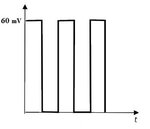ark5230
Advanced Member level 3

I am using approx 1 KHz square wave signal from a detector giving 50 to 60 mV into a load of 3.3K ohms.

I wish to construct amplifier that can give approx 5 V DC output so that it can be used with ADC.
Single supply like LM358 is desirable. I am not getting how to tackle this issue !
A hint how to go about or link to resource will be helpful

I wish to construct amplifier that can give approx 5 V DC output so that it can be used with ADC.
Single supply like LM358 is desirable. I am not getting how to tackle this issue !
A hint how to go about or link to resource will be helpful



